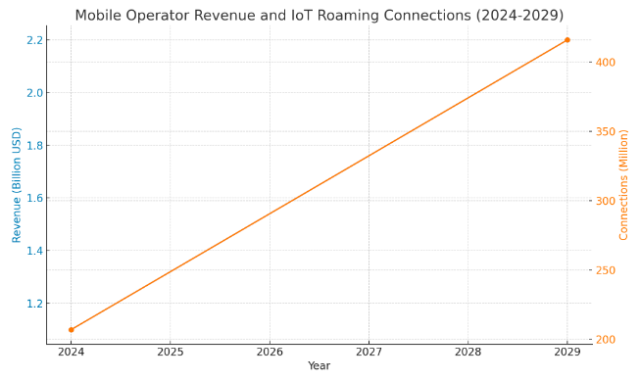A new report by Juniper Research reveals significant opportunities for mobile operators to monetize the rapidly growing IoT roaming business.

The Internet of Things (IoT) is emerging as a lucrative revenue stream, driven by demand for connected devices. However, operators face challenges in converting IoT connectivity into profit due to the unique characteristics of IoT traffic and existing billing models.
IoT Roaming as a Revenue Opportunity
Mobile operators are expected to see revenue from IoT roaming surge from $1.1 billion in 2024 to $2.2 billion by 2029. The number of IoT roaming connections will more than double during this period, from 207 million in 2024 to 416 million by 2029.
IoT connections generate cellular data of 80.4 MB per month per connection in 2024. Roaming charges for IoT devices are substantially higher than for smartphones, creating opportunities for operators to extract more revenue from each connection.
For instance, Vodafone Group says its customers can choose an IoT Connectivity package of 50GB for a price of €20 or 10GB for a price of €10. There are other packages as well. Data usage outside of the agreed plan will incur a charge of 0.016c per MB of data.
Tackling Revenue Leakage
One major challenge highlighted by the report is the issue of revenue leakage in IoT roaming. Many IoT devices transmit data intermittently, and a significant portion of devices go undetected by operators, leading to lost revenues. Current billing systems, such as the TAP (Transferred Account Procedure), are not well-suited for the irregular nature of IoT transmissions, often resulting in operators losing money on IoT roaming services.
To mitigate this, operators are being urged to invest in more advanced billing and charging systems tailored to the specific needs of IoT traffic. Newer systems must be capable of capturing and billing all IoT connections, ensuring that no revenue is missed.
Expanding Value-Added Services
In addition to upgrading billing infrastructure, operators can further monetize IoT roaming by expanding their value-added services. Connectivity management platforms are particularly critical in this context, enabling enterprises to monitor and manage their IoT devices’ connectivity across different networks and geographies.
Given the competitiveness of the connectivity management platform market, telecom operators, IoT connectivity providers, manufacturers, and platform specialists must continuously innovate to maintain and grow their market share. Offering tailored solutions, such as custom roaming steering templates or managed connectivity services, can help enterprises optimize their roaming costs and improve service quality.
Leveraging eSIM Technology for Cost Efficiency
Juniper Research also emphasizes the role of eSIMs in IoT roaming monetization. With eSIM technology, the number of connected devices and sensors is projected to rise from 1.1 billion in 2024 to 3.5 billion by 2029. eSIMs allow devices to switch between different network profiles, helping operators avoid permanent roaming restrictions and enabling enterprises to sidestep high roaming costs in regions like Brazil.
Automating eSIM localization processes, based on rules set by both enterprises and operators, will be key to unlocking new revenue streams. By dynamically switching network profiles, enterprises can optimize connectivity, especially in geographies with challenging network coverage.
5G and AI: The Future of IoT Roaming
To further enhance IoT roaming services, operators are encouraged to invest in 5G networks and AI-driven solutions. These advanced technologies will enable more complex models of traffic and billing, allowing operators to offer enhanced services such as intelligent connectivity selection. This capability ensures IoT devices can seamlessly switch between terrestrial and non-terrestrial networks, such as satellite IoT roaming, based on real-time conditions and enterprise requirements.
The automotive sector, particularly connected vehicles, stands out as a prime example of where intelligent connectivity solutions can add value. As vehicles move across borders, their IoT devices can automatically shift between different networks, optimizing roaming charges and maintaining reliable service.
Strategic Partnerships and AI-Driven Monetization
To fully capitalize on the IoT roaming boom, operators must forge strong partnerships with IoT manufacturers, ensuring their devices are compatible with emerging connectivity solutions. By focusing on high-value IoT use cases such as connected cars and asset tracking, operators can unlock new revenue streams.
AI will be critical in processing the growing volume of IoT roaming traffic and enhancing revenue management. Automated systems powered by AI will allow operators to continuously update traffic and revenue models, ensuring rapid responses to changing market conditions and demand.
By investing in AI technologies and upgrading traditional billing processes, mobile operators are well-positioned to turn the IoT roaming market into a major source of profit.
Baburajan Kizhakedath
